New here? Hi! If you want to get right down to business, scroll down for the new video release and allllll the way to the bottom for the recipe.
True story:
While working at Bon Appétit, I was once mocked and ridiculed for suggesting we run a feature story on tomatoes in the June issue.
“Carla, June is not for tomatoes,” someone yelled at me. “August is tomato season! Tomatoes are the cover—in August.”
In the northeast, yes, tomatoes peak in August. But [coastal elite woman gestures vaguely] in other places they’re peaking right now! Georgia (I’m told). Texas (maybe!?). I’ve heard that in some parts of southern California, it gets so hot in July and August that tomatoes have to take a break!
To continue with the argument I tried to make to my employer seven years ago, if we wait until August to release our tomato recipes, a probably pretty big amount of people won’t even be able to make them until May of the following year! I was scoffed at. I was dismissed. I had failed to make my case.
You know how when you were in middle school and you got roasted by someone in a verbal tiff, and then later when you got home you’d think of the ultimate comeback that would have been amaaaaazing in the moment? Well I guess I’ve been having this fight in my head for the past seven years and here’s the zinger: an absolutely lovely tomato tart, flavored with brown butter, miso, and toasted sesame, at your service in the mother tuckin’ month of May. If you’re in [again, a half-hearted flip of the wrist] one of those places where tomatoes are happening now, bless. New stuff, just for you! There are food editorial people with a lot of power who are going to gate keep tomatoes for three more months. Not me! Justice for early tomatoes! Justice for … whoever lives where that is happening! (Just because I can’t name the 50 states doesn’t mean I’m not thinking about you.)
And for everyone else in the high-summer growing zones, there’s a gift here for you, as well. The upside to this cusp-of-June tomato moment is that you can start messing around with the hothouse tomatoes that show up early (already spotted at Brooklyn farmers markets), then graduate to the field-grown tomatoes from states to the south of you, and then—when you have truly mastered my flaky dough technique and are feeling very show-offy—you can make it with August’s exquisite farmers market specimens. This is the tomato tart equivalent to buying a six-month baby clothes for a nine-month old: you’ll enjoy having it around for that much longer.
There’s also a downside (isn’t that always the way?), but it’s a hex only on me: in order to release this new recipe right now, I had to develop it and shoot the video back in April. I was a little intimidated by the assignment I had given myself, and at that time, the earliest of the early zones weren’t even warmed up. I was working with the types of tomatoes they slap onto refrigerated, pre-made sandwiches in the airport. A crosswise slice revealed a pale pink ring enclosing an almost crunchy, green-pepper-tasting flesh.
An unripe tomato presents two major problems for the recipe developer: the sweetness isn’t there, and the juiciness is missing, too. If I bake a tomato tart with dry tomatoes, I could be fooled into thinking that my time and temperature calculations have resulted in a crisp bottom crust, when really a juicy tomato will sog right through. Or, I might walk away thinking I needed to add a lot more liquid before baking, because no one wants semi-dried tomatoes baked into a barren shell. If the tomato isn’t sweet enough, I might overcompensate with ingredients that will make a ripe tomato tart taste like jam.
So, it’s a little scary. I made this tart at least four times before I felt like it was dialed in, and at that point we shot the video. Then I waited a month, and made it again with the halfway decent tomatoes I can now find find. A couple of moves round out the flavor, and a simple addition helps with the moisture barrier. Because there are a lot of Mediterranean, garlic-olive oil-basil tarts out there, and also many tomato-cheddar or tomato-Parm types, I decided to bring in Asian flavors that pair amazingly well with tomatoes. Miso, which is sweet, salty, savory, and umami; brown-butter, which is nutty and rich; plus soy sauce and fish sauce, which delivery saltiness and depth. I think there’s enough going on to flatter even the sweetest tomato.
The tart is lined with untoasted panko breadcrumbs, which exist to absorb some tomato liquid that is released, and I also rely on a very open crust and high heat to drive off moisture and help the tomatoes caramelize. My first draft of this recipe had two tablespoons, and the final had half a cup.
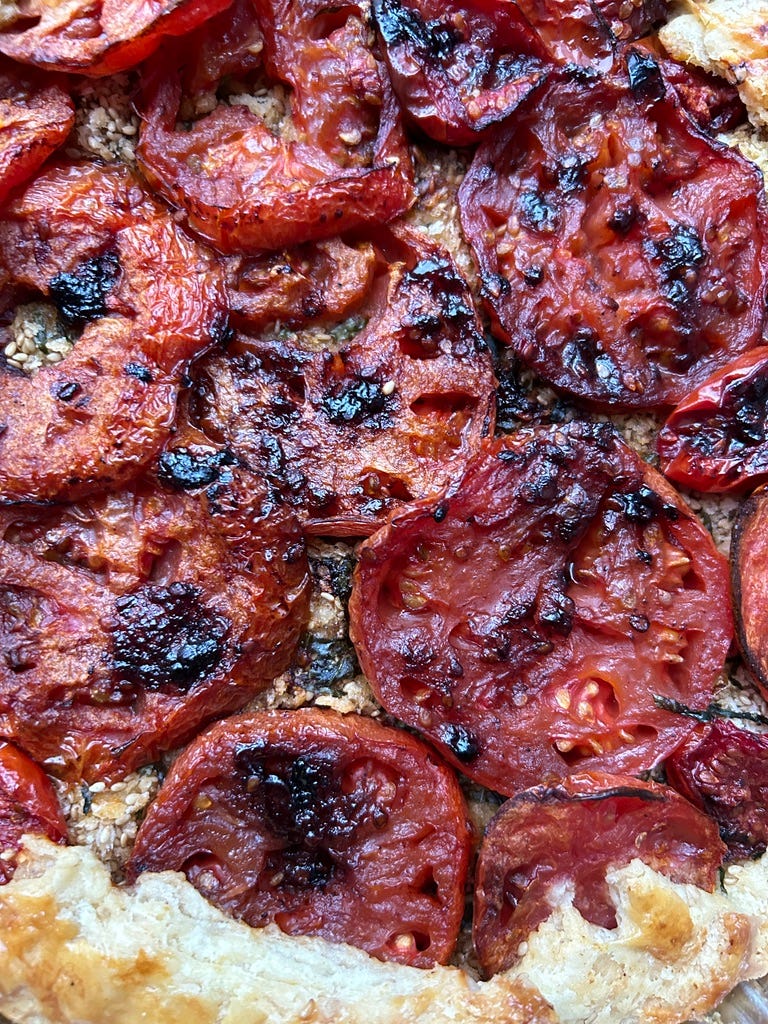
If this is your first time trying my pastry crust, I’ve added sesame seeds! And if you’ve already made it from one of my previously-released iterations here, here, and here, you can rest assured that I did not attempt to fix something that wasn’t broken. That’s another advantage to making a tart with a long tomato season in front of it—plenty of time to practice making the dough! If I were you, I’d make a double batch and put one disc of dough in the freezer. When that perfect tomato makes eyes at you in the market, this whole tart will be only an hour away.
xoCLM
I’ve removed the paywall from this recipe, for the love of tomatoes (and you, of course). If you decide to subscribe anyway, know that your support will go right back into my work developing recipes, shooting videos, and writing about all of it. If you’re reading this, please join us!
Miso-Brown Butter Tomato Tart
8 servings
Savory, salty, and toasty: the soy, miso, and sesame oil in the seasonings are umami-rich ingredients, as are tomatoes, so there is a ton of deep flavor to be found here. A couple words of caution: the recipe calls for just a pound and a half of tomatoes—a single beefsteak could weigh close to a pound. You might be tempted to add more tomatoes. But stick to the weight: This is not a deep-dish pie, and you’re not going to wind up with layers upon layers of tomatoes. Too many tomatoes will flood the crust with liquid, and you’ll end up in soggy bottom city. No one wants that! When you are spreading out the panko, make sure to push them all the way into the edges of the crust; because of the overhang, moisture can get trapped there, and you want there to be panko to absorb the excess.
For the Crust
12 tablespoons (6 ounces/168 g) cold unsalted butter
1 ½ cups (180 g) all-purpose flour, plus more for dusting the surface
1 tablespoon (8 g) toasted sesame seeds
1 teaspoon (5 g) baking powder
1 teaspoon (3 g) kosher salt
1 teaspoon (4 g) sugar
For the Filling and Assembly
4 tablespoons (2 ounces/56 g) unsalted butter
1 tablespoon white or yellow miso
1 ½ teaspoons soy sauce
1 ½ teaspoons toasted sesame oil
1 teaspoon fish sauce
1 teaspoon finely grated ginger, from a small thumb-sized piece
1 ½ pounds medium beefsteak tomatoes
Kosher salt; freshly ground pepper
½ cup panko
2 tablespoons toasted sesame seeds, plus more for serving
Handful basil, plus more for serving
1 tablespoon heavy cream
Make the Dough
Cut 6 ounces butter (1 ½ sticks) into 2-ounce rectangles, then in half lengthwise to create 6 butter planks. Refrigerate the butter while you measure your dry ingredients. In a small bowl or measuring cup, put some ice cubes in about ½ cup (60 ml) water; set aside.
In a medium bowl, toss together flour, sesame seeds, baking powder, salt, and sugar to combine. Add the butter pieces and toss to coat each, then dump the mixture onto a clean work surface. Use a rolling pin to roll butter into flour until butter is flattened and slightly softened, and has formed long, flexible pieces. This will take a little doing. Use a bench scraper or metal spatula to loosen flour from the surface and to clean off rolling pin as needed.
Use bench scraper to corral mixture into a loose round pile, then drizzle ¼ cup (60 ml) of the reserved ice water (without ice cubes) over. Using the bench scraper and your free hand, toss mixture until the liquid is evenly distributed. It will resemble dampened clumps of flour with lots of loose bits still in the mix, and this is exactly as it should be.
Gather mixture into a 6-inch-wide rectangle with one short end toward you, then dust dough lightly with flour. Roll out dough to about ¼ inch thick. Scrape the rolling pin clean as needed, letting scraps fall onto the dough as you go. The middle will be loosely holding together but the edges will look very dry and shaggy.
Using the bench scraper, fold the top third over the center, then fold the bottom third up and over, as you would fold a letter. Rotate dough 90 degrees and roll out again (flouring and scraping the rolling pin as needed). Fold into thirds again, rotate 90 degrees, and roll out a third time. At this point, the dough should be somewhat homogenous and creamy-looking, with some dryness at the long edges. Squeeze a bit in your palm; it should loosely hold together. If not, repeat the rolling and folding a fourth time, then check again. Fold dough in thirds and press it into a disc about 1 inch thick and 9 inches across. Wrap tightly; chill 30 minutes or up to 2 days.
Do Ahead: Dough can be frozen for up to 3 months; after wrapping in plastic, place in a freezer bag.
.
Make the Filling and Bake
In a small saucepan, melt 4 tablespoons butter over medium heat, then cook, stirring and scraping, until the butter solids are browned and the foaming has subsided, 4 or 5 minutes. Let brown butter sit until cooled to room temperature.
While the butter cools, combine the miso, sesame oil, soy sauce, fish sauce, and ginger in a medium bowl and whisk to combine. Spoon the foam off the cooled butter (discard), then whisk into the miso mixture. Cut the tomatoes into ½-inch slices and add to the miso mixture. Season with salt and pepper and use your hands or a flexible spatula to toss very gently to coat. The butter will look chunky and congealed at the start, but as the tomatoes release their liquid, it will smooth out.
Preheat the oven to 400°F with convection on (if possible). Roll out the dough on a lightly floured surface to a 13- or 14-inch round, then carefully transfer it to a 9- or 10-inch removable bottom fluted tart pan. Press the dough into the pan and firmly against the inside of the rim, allowing any excess to drape over the edge.
Do Ahead: Dough can be rolled out and fitted into tart pan up to two days ahead; seal airtight and keep chilled.
Sprinkle the panko and 2 tablespoons toasted sesame seeds evenly over the dough, paying attention to the outer edge, where liquid from the tomatoes can get trapped during baking. Thinly slice the basil and scatter over the crumb mixture. Place the tomatoes on top of the crumbs, layering evenly, then pour any accumulated liquid from the bowl over the tomatoes.
Fold the dough overhang onto the tart to create a rustic crust, as you would a galette, then brush exposed parts of the dough with cream. Transfer tart to a rimmed baking sheet and bake for 10 minutes. Lower the oven temperature to 350°F and continue baking until the crust is deep golden brown, the tomatoes have shriveled and started to brown, and the juices are bubbling, 35 to 40 minutes longer.
Let tart cool completely before removing ring. Top with more basil and sesame seeds, then cut into wedges.
From the Market
Ginger
Beefsteak tomatoes
Basil
Heavy cream
Spin It
Use a teaspoon of lemon zest instead of ginger
Any type of basil would be great—Thai, purple, Genovese
A beaten egg can replace the heavy cream
At Home
Butter
Flour
Sesame seeds
Baking powder
Salt and pepper
Sugar
Soy sauce
Sesame oil
Fish sauce
Panko
Spin It
Poppy seeds can replace the sesame seeds, or omit
Tamari or aminos can be used instead of soy
A dab of anchovy paste or two mashed anchovies can be used instead of fish sauce, or omit
Any dried bread crumb can be used instead of panko




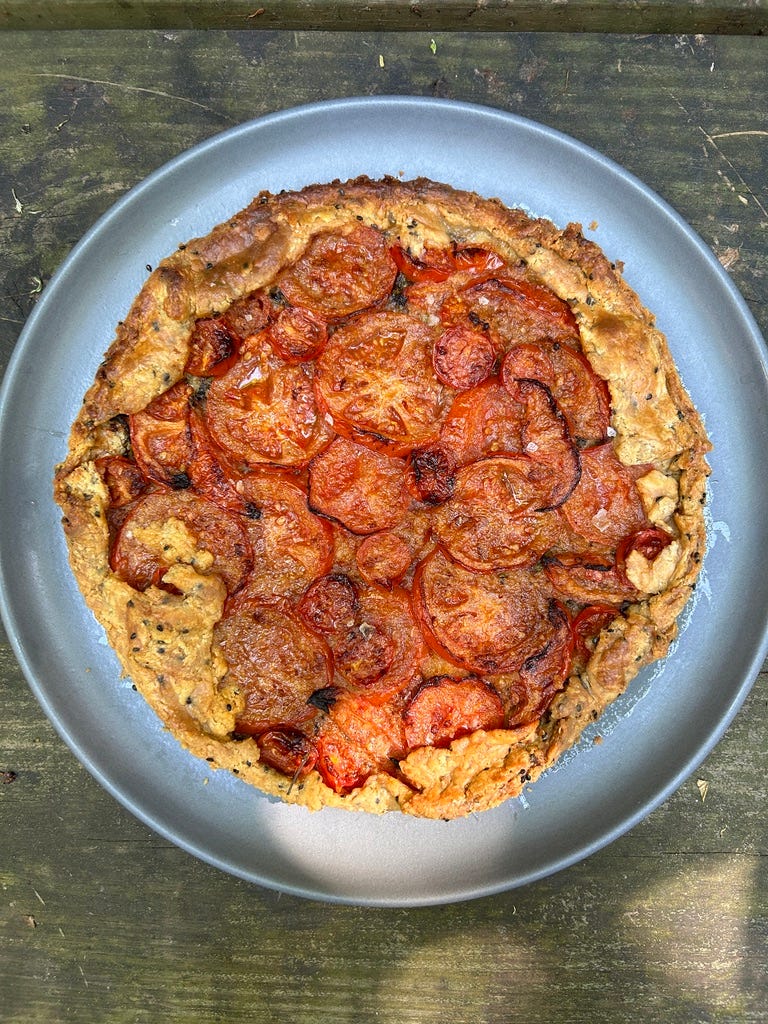
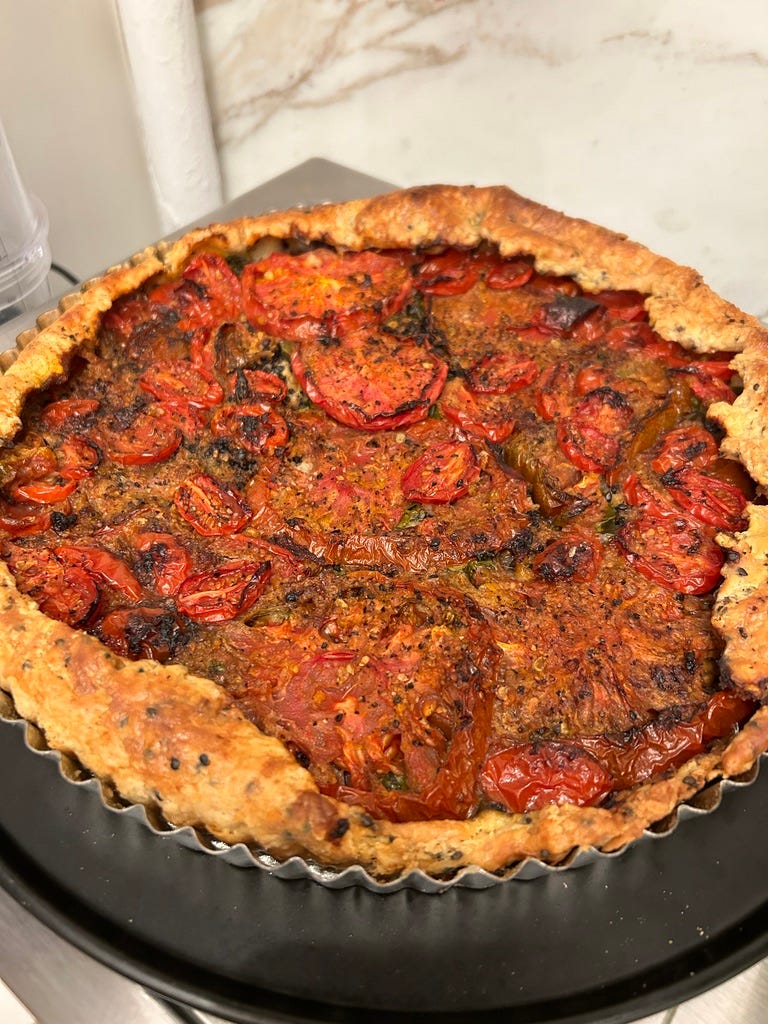
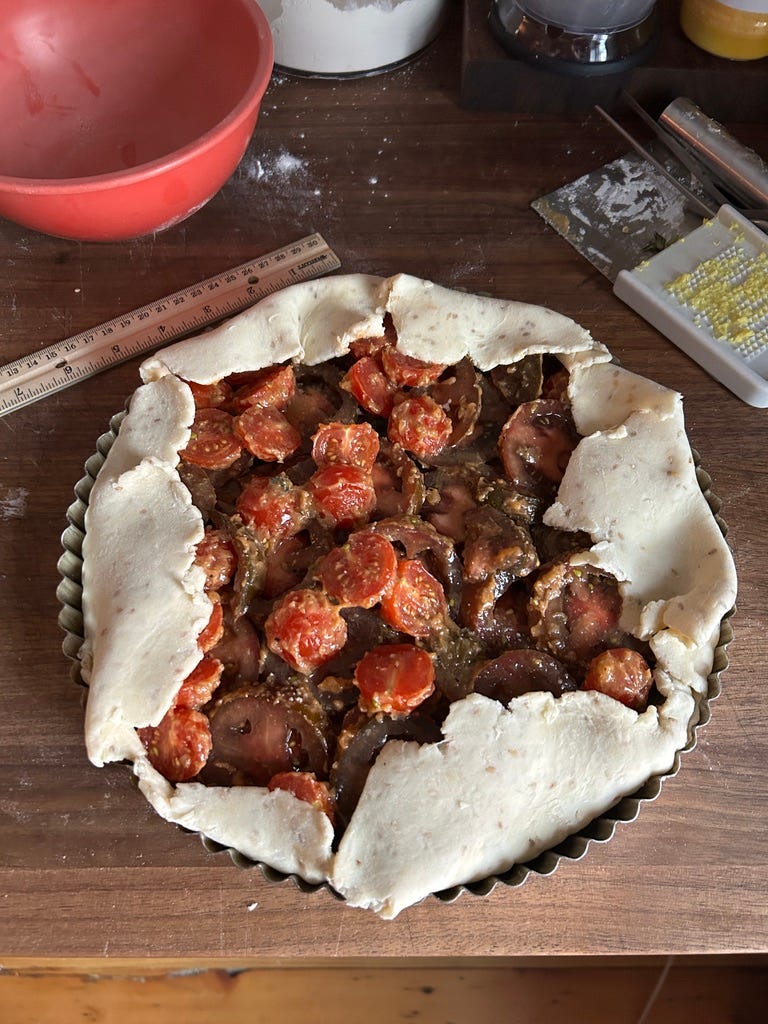
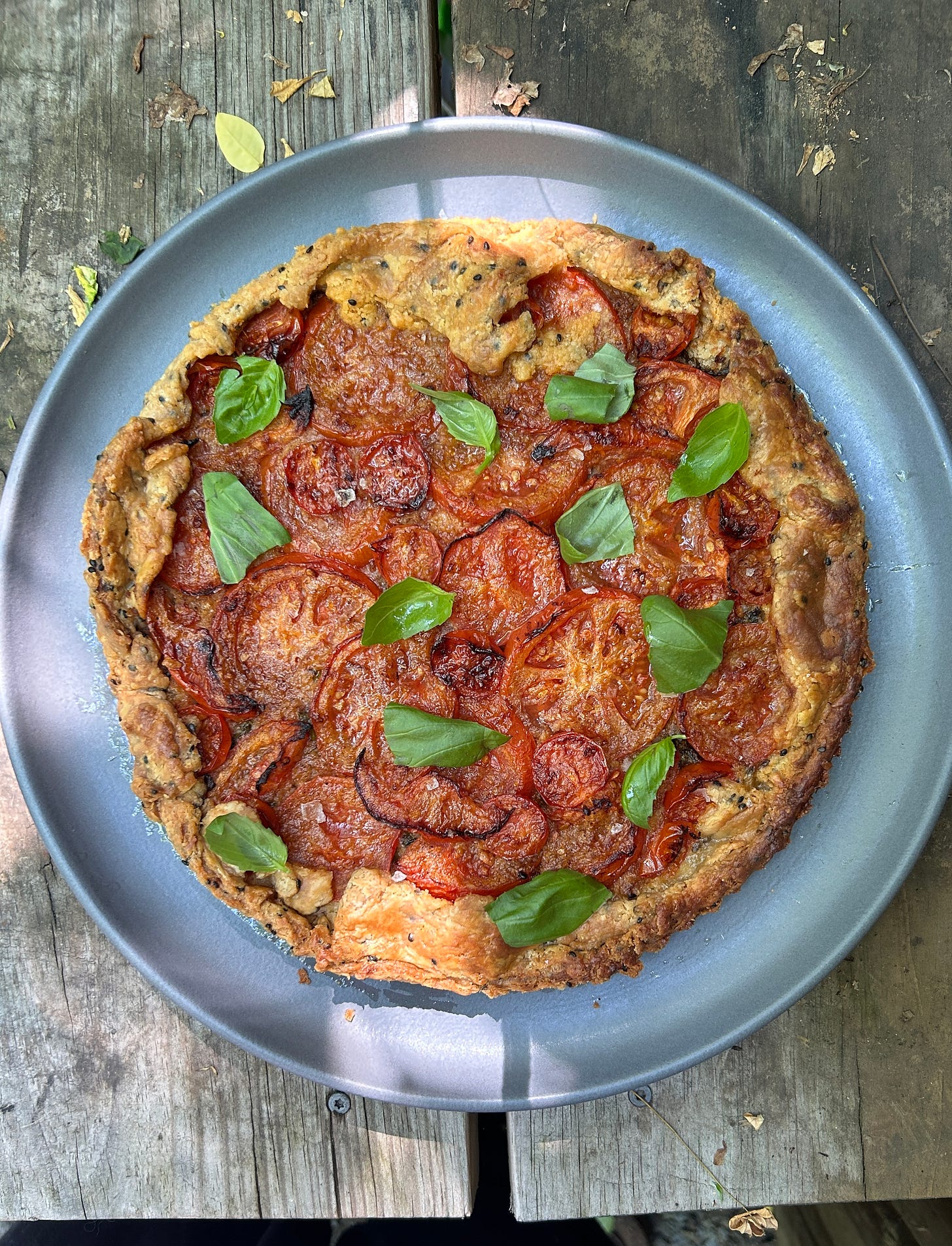
For this tomato-loving woman who lives in Georgia and is already knee deep in tomato toasts of all kinds, thank you! You see us and I, for one, appreciate you for it.
I am in Houston and it is tomato season for us now. August is too hot for tomatoes, but we do get another crop in the fall so we can make this now and again in September or October.